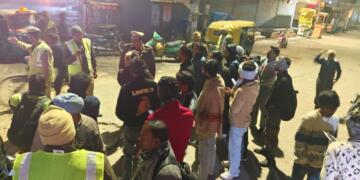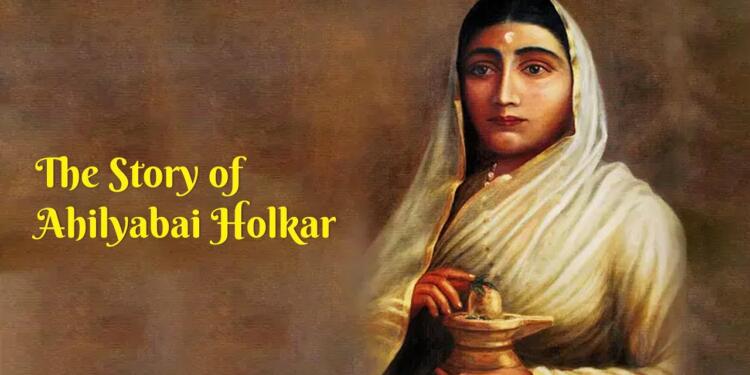It has been often witnessed that the communist-leaning historians have often derided and mocked our native history, terming Bharat/India as patriarchal or backward, often believing in regressive superstitions. However, the fault did not lie in our beliefs, rather we lacked proper evidence and examples of people, who could force the left-liberal historians to keep their mouths shut for good.
One such person was Ahilyabai Holkar, the ever-famous Subedarni of Indore, whose life is enough to make the communist-leaning historians, often barking patriarchy at the drop of a hat, go AWOL. Born on 31 May 1725, it was due to this brave warrior queen that our cultural identity is still preserved. It is due to this brave queen, that the idea of Bharat stays intact.
‘Punyashlok’ Ahilyabai Holkar was born to a wealthy agrarian Patil community of Shindes, at Chaundi village in Ahmadnagar, what constitutes modern Maharashtra. Her father, Mankoji Shinde, was well respected throughout his community. Contrary to societal norms, even though Ahilyabai was engaged at the tender age of 8, her education was never ignored. Some can even say she literally earned it. Her tenacity impressed her father-in-law, Malhar Rao, who made sure that her education and her tutelage is taken care of, under the guardianship of his wife, Gautamabai. Malhar Rao was none other than the same Malhar Rao Holkar, who was the loyal commander to Peshwa Bajirao Ballal, one of the greatest warriors the soil of Bharat has ever produced till date. Now, how is this in anyway backwardness, according to the so-called norms set by the left-liberal custodians of history?
This was the time when Indian politics took a decisive turn. Though Peshwa Bajirao was no more, his sons, Peshwa Balaji Bajirao, and Raghunath Rao, had taken a vow to complete his unfulfilled dream of spreading the Hindavi Swarajya throughout the length and breadth of Akhanda Bharat. Malhar Rao Holkar, though growing old, had a significant role to play in the same. He was content, both politically and personally, and it seemed as if life was bliss, when calamity struck the Holkars real hard.
During a war campaign, Ahilyabai’s husband, Khanderao Holkar, accompanied Malhar Rao. He was in an open palanquin, inspecting his troops. All of a sudden, the enemy’s cannonball struck him, killing him on the spot. Some say they were Mughals, some say they were Jats, though the actual killers remain unknown till date.
Ahilyabai Holkar had lost her will to live. She had decided to commit Sati, even though this was neither required, nor that was the norm amongst the Marathi community. Eventually, she was persuaded by Malharrao Holkar to give up her idea, and raised like his own son.
Ahilyabai Holkar had barely managed to gather herself somehow, when another calamity struck, but this time, it was just not the Holkars. The loss in the Third Battle of Panipat was devastating for the entire nation, for not only millions were slaughtered in the war imposed by the tyrannical Afghan despot, Ahmad Shah Durrani, but it also claimed the crème de la crème of the Maratha clan, including Sadashiv Rao Bhau, Vishwasrao Bhat, the heir to Hindavi Swarajya, Krishna Rao ala Shamsher Bahadur, as well as Peshwa Balaji Rao himself. Though Malhar Rao Holkar, like Nana Phadnavis and Mahadji Shinde, was among the lucky few to have survived the carnage, he could never fully recover from the scars incurred in Panipat, and he passed away in 1766.
As such, the administration of Indore, as well as central India, came under Ahilyabai Holkar. These were hard times, especially since Raghunath Rao, once the pride of Bharat, was now the shadow of himself. A scheming man, who just wanted the throne of Peshwa for himself, he wanted to overthrow the young but resolute Peshwa, Madhavrao Bhat. However, Madhavrao had other plans, and he needed good people to help him secure his plans.
Also Read: Hinduism: The true essence of women empowerment
After overpowering Raghunath Rao, he took help of Nana Phadnavis to help him administer his Empire. This was the period which even European historians refer to as “Maratha Resurrection”. India could have been enslaved within the 18th century, but it was delayed a century further, thanks to a strong Maratha confederacy created by Peshwa Madhavrao, with advisors like Nana Phadnavis, cultural ambassadors like Ahilyabai Holkar and military commanders like Mahadji Shinde to help him regain the pride lost at the battlefields of Panipat.
It is due to Ahilyabai Holkar, that the present Kashi Vishwanath complex, restored in complete grandeur by PM Narendra Modi, was constructed. It is due to Ahilyabai Holkar, that Bharat, which suffered cultural setbacks, thanks to incessant Islamic and European invasions, was somewhat, if not completely, restored to the glory of the yesteryears. From restoring many old temples, to opening community centers, taking care of scholars, temple priests, opening granaries, wells and a lot more, you name and Ahilyabai Holkar did it all. They say that with the fall of the Marathas at Panipat, the seeds of India’s slavery were sown. However, to be honest, with the untimely demise of Mahadji Shinde in 1794, and later Ahilyabai Holkar in 1795, the effective resistance that was being provided to the Europeans, particularly the British imperialists, was broken, and the English East India Company had a field run towards their route to absolute power in India.































